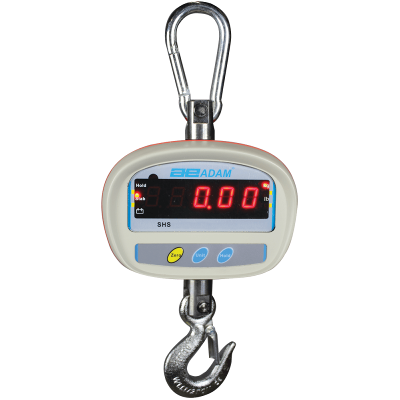A Guide to Hanging Scales

What are hanging scales?
Hanging scales, also called crane scales, work a bit differently than ordinary scales. Instead of putting a load on a weighing pan or a platform, the load is suspended using the crane scale's hook. The scale itself can hang from machinery, hooks and other apparatuses. Depending on the capacity, users could put the hanging scale on something like a mechanized crane to lift very heavy things or simply hold a simple spring hanging scales in their hands to measure a fish. This post will focus on a few important features to consider when purchasing a heavy duty hanging scale.
Types of hanging scales
There are analog models sold (called spring hanging scales), but since Adam only has digital models, that's what we'll focus on. Our range of hanging scales include the IHS, the LHS and the SHS. There are a few advantages to digital models, like the bright, highly visible display. It's not uncommon for digital hanging scales to be used remotely to improve safety, so a scale with results visible from afar is very helpful and helps to prevent mistakes when recording the results. Digital hanging scales also work more quickly, which improves efficiency. Crane scales can also lift much heavier weights, hence their common usage in industrial settings.
What are hanging scales used for?
Hanging scales have many different applications, ranging from weighing fishing nets or luggage to measuring fruits and vegetables. The industrial sector often uses hanging crane scales to weigh very heavy loads because they can withstand rigorous conditions despite a compact frame, which makes transport easy. While a platform scale or a high capacity floor scale can take a lot of space, a hanging scale can be stored in a relatively small case when not in use.

A solid safety hook ensures the load is secured and helps prevent accidents. Adam's crane scales have an oversized shackle that rotates to suspend loads with ease. The shackle locks into place during weighing.
Common features of hanging scales
One of the most useful features on crane scales is the remote control operation. Crane scales can be used from afar, allowing users to weigh very heavy, bulky loads at a safe distance. The remote control allows safe, hands-free operation.
Robust housing ensures that the hanging crane scales can withstand demanding environments such as harbors, airports, factories, postal facilities and more. Still, the scale should be treated with care. Don't drop or hit the scale.
A long battery life can be very helpful, especially when weighing hay or livestock, since electricity might not be readily available. Sometimes, zoos or conservation parks use hanging scales to weigh heavy animals like deer or bears.

The tare function allows users to remove the weight of nets, baskets, scoops and other containers used to store the loads. LEDs display battery life, units and other relevant information in a quick glance.
Using a hanging scale safely
It's important to keep track of the scale's capacity. Crane scales can be sturdy and designed for heavy duty weighing, but it's still paramount for users to stay safe and never go over the scale's capacity. Other useful tips include making sure that the loop you use to hold the crane scale is adapted to the tool you use it with (for example, make sure that the crane's hook isn't so big it'll scratch the point of attachment) and calibrating frequently.
These aren't all the features and applications of hanging scales, merely some you should consider when buying a hanging scale for industrial applications. Feel free to contact us to learn more, and follow us on social media for more blog posts and the latest news from Adam Equipment.


